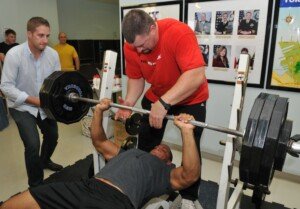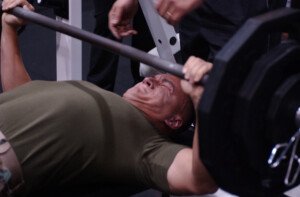
It’s crazy that people actually think that a spotter can CATCH a barbell in free-fall after it drops from a suicide grip!
Have these ding-dongs ever spotted?
I was inspired to write this article after reading the dopey comments to a news story about Kyle Thomson, 22, of Iowa State who was bench pressing 315 pounds when the barbell suddenly fell from his hands and fatally crushed his neck.
Reportedly there were “spotters” present when the “barbell slipped from the member’s hands.”
The only logical explanation for the slip is the suicide grip (thumbless, just using the palm to support the bar).
The story garnered nearly a hundred comments (excluding replies to them). I just could not believe how many people posted comments to the effect of:
• “Why weren’t the spotters doing their job?”
• “Isn’t a spotter supposed to prevent the barbell from falling?”
• “What’s the point of having spotters if they can’t help?”
• “What were the spotters doing when the barbell fell?”
• “Weren’t the spotters paying attention?”
These commenters do not have to have bench pressing or spotting experience to know how utterly impossible it would be for a person to catch a 315 pound barbell in mid-air that unexpectedly and instantly slips out of the user’s suicide grip.
This is NOT the same as the athlete suddenly wavering and pausing, with the barbell still in their hands.

This far more common scenario gives a spotter plenty of reaction time to grab the bar and, with the athlete’s hands still on it, help him or her lift it back up and rack it.
When I was a personal trainer at a gym, I had male (and female) clients, and I spotted them for heavy lifts.
Of course, I did not permit the suicide grip, so it would’ve been impossible for the bar to suddenly slip out of their hands and free fall.
But I was always prepared for a sudden loss of control of the bar. And that happened. And I helped pull it back up without incident.
But that kind of spotting is not the same as the bar actually disconnecting from the hands and free-falling towards (and onto) the person’s chest or neck.
Even if you KNOW that in three seconds, the barbell is going to drop, you will NOT be able to catch it before it makes contact with the athlete’s neck or chest if you’re standing behind the athlete’s head.
Unless the bar weighs 45 pounds. Maybe 75. But not 315!
Basic Physics of a Free-Falling Object
When an object starts falling, it accelerates at 32 feet per second squared.
If an object is dropped from a point high enough above you, you can catch it. But what if you’re standing over someone as a spotter who’s bench pressing?
The distance you’d be working with to catch the weight is however many inches are between the barbell and the athlete’s neck or chest.
Unless you live in an accelerated time frame like the Scalosians did on the classic “Star Trek” episode called “Wink of an Eye,” you are not going to process the movement of that falling weight fast enough to catch it within such a confined vertical space.
Oh, unless you’re Superman, of course, who can see the movement of bullets and intercept them.
But let’s suppose you COULD react fast enough.
You STILL would not be able to catch a 315 pound barbell from the position of a spotter!
The spotter is standing behind the head of the athlete and slightly bent over, hands hovering over the bar or under it.
The bar slips from the suicide grip. The spotter grabs it when it’s fallen only four inches (assume the spotter has the Scalosians’ abilities — they see everything in super slow motion).
Tell me, just how is a person — even the strongest man in the gym — going to support the weight of 315 pounds in his position of standing bent over the bar?
Do you realize how much strength this would require?
Being able to bench press and deadlift 315 pounds does NOT mean you can hold this weight in mid-air after catching it with bent arms from a slightly bent-over position.
What about a spotting duo stationed on either side of the barbell?
Though both men would have the strength to control a very heavy barbell, the problem would be their reaction time as it suddenly and unexpectedly free-falls from a suicide grip.
They wouldn’t be able to react quickly enough to grab it before it struck the athlete’s body.
Go ahead, try it: Stand in the spotter’s position at a bench press station and see if you can pick a 315 pound barbell off the rack from such a biomechanically compromised position.
You won’t get it up even an inch. If you can’t do this, you can’t catch it in mid-air, either.
So what good is a spotter for a bench press then?
• Help the athlete get the bar off the rack and back on the rack.
• Add help when the lifter is struggling to push the bar back up.
• Assist in the lowering of the bar; the spotter’s hands are around the bar, pulling it upward to subtract weight. This upward pull may be only 10 pounds of force, but that’s all that may be needed.
A spotter is NOT able to catch a barbell in mid-air and hold it there.
Once again, a barbell that slips out of the athlete’s suicide grip is going to hit his neck or chest before the spotter knows what’s happening.
In the case of a suicide grip, this happens in a second. In the case of cramping, fatiguing arms, the lifter is able to say, while still somewhat controlling the weight, “Take it! Take it!” or some other warning.
The spotter can grab it and, with the fatigued lifter’s help, both can set it back on the rack. This is not a slip. This is not a drop. There is no free-fall. The suicide grip in the bench press is aptly named.
























